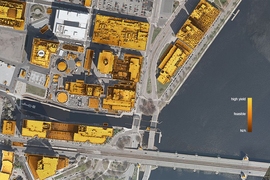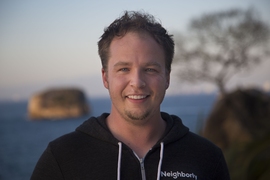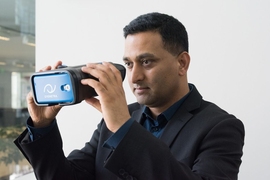The School of Architecture and Planning (SA+P) has launched a new entrepreneurship accelerator, DesignX, to cultivate and assist students and faculty developing products, systems, and companies that focus on design and the built environment.
“Design is the art and science of improving the interface between human beings and their environment,” says Hashim Sarkis, dean of the School of Architecture and Planning. “DesignX will support entrepreneurs who work in this arena and help them speed their innovations to the marketplace.”
Nicknamed “DESx,” the program launches this fall to provide SA+P students with a structured set of classes, mentorship, seed funding, research, and links to the global network of SA+P alumni entrepreneurs. The centerpiece of the program is a four-month, for-credit accelerator workshop offered during the January Independent Activities Period (IAP) and the spring semester. To help students make the critical leap from project to startup, participants will have the chance to connect with external investors and industry partners to make their pitches.
“Innovators and entrepreneurs in SA+P draw upon broad strengths in design-oriented disciplines and deep expertise in the built environment, including architecture, planning, art, media, and real estate development,” says Dennis Frenchman, the Class of 1922 Professor of Urban Design and Planning and faculty director of the program. “Introducing DesignX into MIT’s ecosystem for entrepreneurship will offer these individuals resources specifically tailored to develop, scale, and deliver their ideas for real-world impact.”
The DESx program is structured in three phases characterized as “learn, launch, and leap.” Individuals or teams — which can include faculty members and which must have at least one member from SA+P — will:
- Learn: In the fall semester, student team members prepare for the program by selecting from a short list of elective courses in entrepreneurship and innovation offered across MIT. At the end of the semester, they apply to the program by pitching their idea to a committee including a range of design professionals, entrepreneurs, and faculty drawn from each of SA+P’s departments.
- Launch: Selected participants receive up to $15,000 in seed funding and must enroll in the DESx accelerator workshop in the spring semester. The accelerator is structured to help teams develop their design concepts and create viable business plans and prototypes with the aid of a tailored entrepreneurial curriculum, dedicated mentors, and a supportive industry network.
- Leap: Participants conclude the accelerator workshop with a pitch to outside investors or other potential partners — and start their post-MIT careers equipped to launch and scale their ventures.
“DESx will integrate the initial stages of building a startup into participants’ education, so that students make rapid progress while they are at MIT and are positioned to succeed as they take their first steps toward entrepreneurship,” says Gilad Rosenzweig, the program’s executive director.
A signature component of DESx is research on innovation itself. A team of researchers led by Andrea Chegut, research scientist in the MIT Center for Real Estate and director of the MIT Real Estate Innovation Lab, is studying the landscape for startup companies that emerge from SA+P, and globally, to understand what works — and what doesn’t — when deploying innovations in cities and design.
“A recent study of MIT alumni shows that more than 1,200 companies have already come out of the School of Architecture and Planning. We’re studying who those firms are, what makes them tick, and what makes them distinct from other types of businesses,” Chegut says. “We’ll apply this knowledge to DESx, to enable our entrepreneurs understand the nuts and bolts they need to form successful organizations.”
SA+P firms contribute to both the physical and digital realms, and the impact of these firms can be felt worldwide, says Matthew Claudel, a PhD student in the Department of Urban Studies and Planning and head of partnerships for the DESx team. Claudel cites recently founded SA+P firms that are producing innovation-driven enterprises across industries, such as coUrbanize, a digital platform for linking cities, communities, and developers; Coeio, green burial products for people and pets; Neighborly, a crowdsourced investment platform for municipal debt; Mapdwell, an architectural and geographic information system solution for finding solar panel hotspots on building roofs; and EyeNetra, which produces smartphone-powered devices for eye testing.
The innovation landscape has changed rapidly in recent years, explains Frenchman, who started his own design firm three years after graduating from MIT in the 1970s with dual master’s degrees in architecture and city planning. Disappearing are the days when a young graduate in design, architecture, media, art, or planning would work as an intern for years before gaining acceptance into a profession or venturing out to start his or her own company. “Cities and circumstances are changing so fast that, in a sense, we’re all professionals now. Faculty, students, companies, and communities are co-creating new solutions to problems,” he says.
Beyond providing a platform for innovation, DESx aims to foster the sense of social responsibility that motivates many SA+P students.
“When you’re in the complexity of a city, you’re trying to invent with so many different stakeholders at once. You’re dealing with people’s lives,” Chegut says. “The vision for DESx is to create a place that’s inventive and creative from a design focus, but that’s also grounded in responsible entrepreneurship.”
In some ways, DESx seeks to harness the innovative social spirit that already surrounds SA+P, says Frenchman.
“Our students and alumni are passionate. Each of them wants to make the world better, more functional, but also more just and equitable,” says Frenchman. “And through the companies they’ve founded, our SA+P graduates have improved a lot of lives. DESx will build upon this remarkable tradition.”









